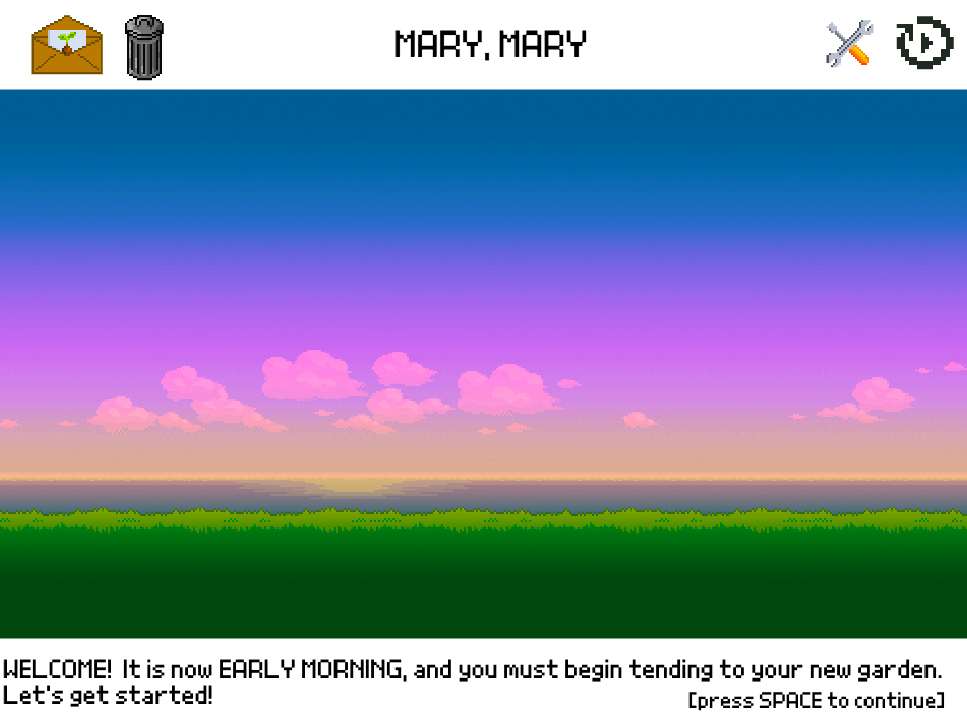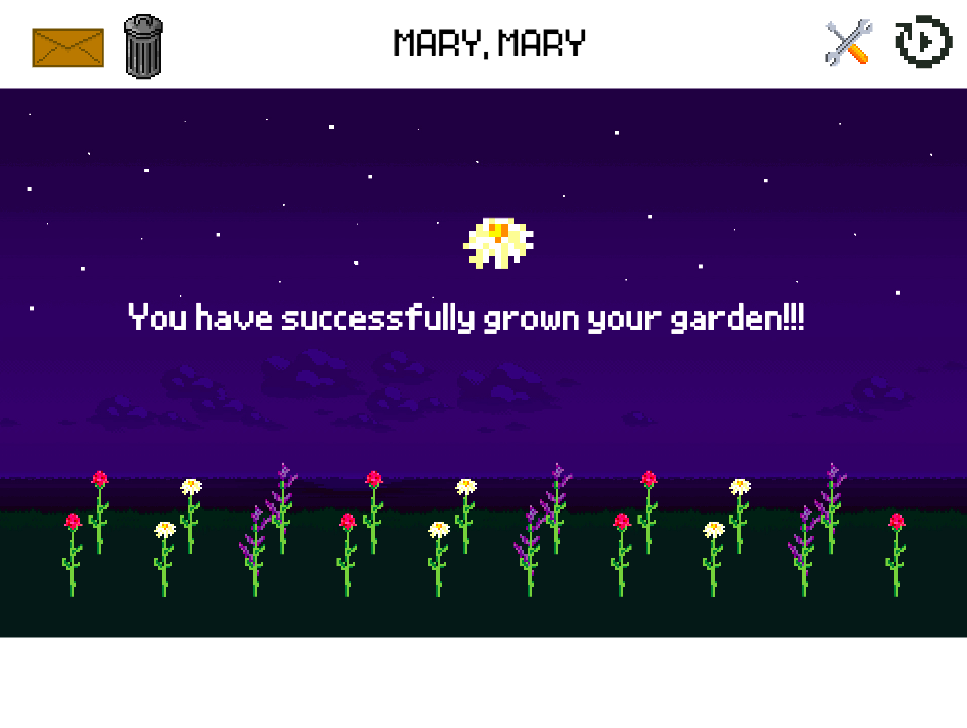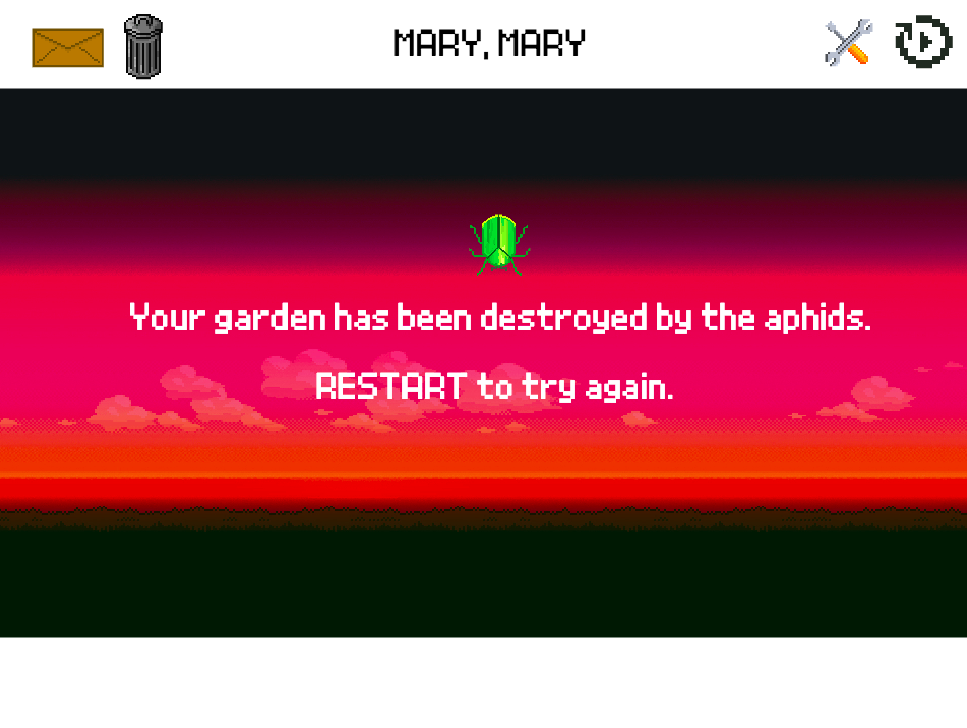 |
 |
 |
 |
This semester's course has explored issues of gender and technology, as well as their intersections. Game design is a very tangible example of the intersections between these two studies — and, when done intentionally, can challenge the expectations which hold their standards in place.
This game, which gets its namesake from the well-known nursery rhyme, seeks to present contrary aspects of a seemingly simple activity: gardening. A game of both cultivation and defense, tranquility and urgency, femininity and masculinity and total androgyny, it compels the player to focus all of their attention mindfully toward one thing: tending to a garden.
“Mary, Mary” contains two stages: one where the player is simply designing and growing their garden, and one where the player must defend the garden they created from attack by aphids.
Objective: Grow and protect a tranquil flower garden.
Protagonist: Players, flowers, & garden.
Antagonist: Aphids.
Setting: Players, flowers, & garden.
This game takes the player through (time-distorted) day of tending to a flower garden. The cultivation of the flowers, however, is threatened by aphids — and the player is tasked with protecting them.
With the exception of the backdrops, used with permission, all elements of “Mary, Mary” were drawn and created by me.
Backgrounds: The various backgrounds used — pixelated landscapes with shifting hues and tones to reflect changes in the time of day — were chosen to mirror the sense of tranquility which this game was designed to present. The stage set is one of the natural world, of time, of consistency, and of calm. The background artwork was created by Reddit user u/BloodyMarvellous and used with permission.
Flowers: The overarching intention of this game was to create a sense of tranquility — and, with the aphids, a sense of defending such tranquility. I chose to illustrate three specific types of flowers — chamomile, lavender, and roses — because all three are known, in teas and other applications, to promote relaxation and presence.
Aphids: In a gardening game, aphids are the obvious opponent as insects which are incredibly destructive to a garden. They also represent a slow-building invasion; in mindfulness practice, which this game attempts to sample, this may take the form of invasive thoughts.
User interface and "game feel" elements: The trash can and seed packet are rather essential to the game’s infrastructure, as they allow for the player to select and adjust the flowers they wish to grow. The settings icon instructs the player on how to turn off the music — again, chosen for a sense of tranquility — to make the game feel more flexible and afford the player agency in the feel of the game.
Music selection: The music selected is “The Mighty Rio Grande” by This Will Destroy You. It is a calm, slowly-building instrumental piece which, as indicated by its name, expresses elements of the natural world. The music can be turned off by pressing the “q” key, providing the player with agency over their in-game experience.
Overview: I have often viewed nature and the natural world as perhaps the one aspect of reality untouched by the stereotypes and prescribed gender expectations promoted within human society. This game places emphasis on these aspects of the world, portraying the player as a “divine hand” outside the game who seeks to cultivate the growth of this natural world.
Feminine vs. Masculine Elements:
Though hegemonic masculinity may attempt to co-opt the “ruggedness” required for connection with the outdoors, and though prescribed femininity may appropriate the delicacy of flowers or the colors of a sunrise, nature is fundamentally a non-gendered entity, as gender is (in my view) only a construct of society. Perhaps due to its nature as a caretaking endeavor and perhaps due to its essential domestication, gardening is traditionally associated with femininity, but I sought to present it in a more androgynous manner by emphasizing primarily the natural elements. I did this by forgoing the creation of a humanoid character, which would automatically be forced to adhere to some physical presentation of gender, and opting to have the player interact solely with the plants and other non-human “characters.”
So, while the game leans visually toward femininity — purple and pink, a soft aesthetic, flowers, and a generally pacifistic tone — the addition of a second stage, with the aphids, seeks to provide a masculine angle as well. I find insects are often associated with masculinity, especially juvenile masculinity, due to their perception as “gross.” Further, the player must kill the aphids — a quasi-aggressive act which clashes with the docility expected of true femininity. The game places the gardner — again, a hegemonically maternal and nurturing protagonist — under attack with the arrival of the aphids, forcing them into the role of a(n admittedly gentle) fighter — a protective, combative role often assumed by masculine figures.